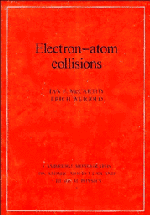Book contents
- Frontmatter
- Contents
- Preface
- 1 Introduction
- 2 Experimental techniques for cross-section measurements
- 3 Background quantum mechanics in the atomic context
- 4 One-electron problems
- 5 Theory of atomic bound states
- 6 Formal scattering theory
- 7 Calculation of scattering amplitudes
- 8 Spin-independent scattering observables
- 9 Spin-dependent scattering observables
- 10 Ionisation
- 11 Electron momentum spectroscopy
- References
- Index
8 - Spin-independent scattering observables
Published online by Cambridge University Press: 15 December 2009
- Frontmatter
- Contents
- Preface
- 1 Introduction
- 2 Experimental techniques for cross-section measurements
- 3 Background quantum mechanics in the atomic context
- 4 One-electron problems
- 5 Theory of atomic bound states
- 6 Formal scattering theory
- 7 Calculation of scattering amplitudes
- 8 Spin-independent scattering observables
- 9 Spin-dependent scattering observables
- 10 Ionisation
- 11 Electron momentum spectroscopy
- References
- Index
Summary
To understand an electron–atom collision means to be able to calculate correctly the T-matrix elements for excitations from a completely-specified entrance channel to a completely-specified exit channel. Quantities that can be observed experimentally depend on bilinear combinations of T-matrix elements. For example the differential cross section (6.55) is given by the absolute squares of T-matrix elements summed and averaged over magnetic quantum numbers that are not observed in the final and initial states respectively. This chapter is concerned with differential and total cross sections and with quantities related to selected magnetic substates of the atom.
In the study of electron–atom collisions there has been a constant emphasis on increasing the state selectivity of the particles in both the initial and final states. Thus while total cross section measurements define the initial kinetic energies, measurements of differential cross sections as a function of angle give additional information on the final momentum states of the separating particles. Added state selectivity is obtained through the use of spin-polarised electrons, or spin-polarised atoms, and with spin analysis of scattered particles (see e.g. Kessler (1985)). The great progress that has been made with the use of spin-selected particles will be discussed in the next chapter. Much of the progress that has been made has been for the case of elastic scattering.
Collisional alignment and orientation
The status for inelastic collisions is a little less satisfactory than for elastic collisions. Collisional excitation of atoms involves excited states with several magnetic substates.
- Type
- Chapter
- Information
- Electron-Atom Collisions , pp. 199 - 234Publisher: Cambridge University PressPrint publication year: 1995

